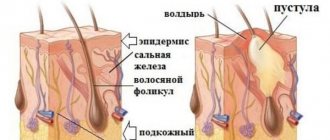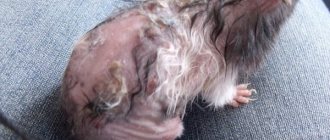Hairless cats may develop spots on their skin.
Owners of hairless cats do not have problems with the hair of their animals, since they simply do not have it. This makes caring for your pet much easier. There is no need to comb him or bathe him very often. However, they are faced with another problem - the appearance of dark spots on the surface of the animal's body. Where do they come from? Why do they arise? How to deal with them, and should you be scared if one morning your pet turns into a spotted leopard? We will talk about all this today on the pages of our new article...
Reasons for appearance
Speaking about the reasons for the appearance of spots on the skin of a sphinx, first of all it is worth noting that they can be different. So, the following can lead to the development of pathology:
- Dermatitis;
- Vasculitis;
- Fungal diseases.
Let's look at how rashes manifest themselves and how they are treated in one case or another.
Dermatitis
Dermatitis is a direct consequence of contact with one or another allergen and can be accompanied by the appearance on the animal’s skin:
- Ulcers;
- Eosinophilic plaques - oval red spots on the thighs and abdomen;
- Eosinophilic granulomas - pinkish-yellow plaques in the mouth or on the thighs;
In addition, allergic manifestations may include common skin symptoms - redness, dandruff and itching. The animal scratches itchy places, as a result of which wounds and eczema appear on its body.
Dermatitis can be managed by eliminating contact with potential allergens. The cat should be put on a hypoallergenic diet (lamb and rice), and antihistamines and steroids should be used to alleviate its condition.
Vasculitis
Vasculitis of the skin is a pathology accompanied by inflammation of the vascular walls and developing against the background of:
- Infections (mycoplasma, staphylococci, viruses, streptococci, fungi);
- Use of certain medications (antibacterial drugs, vitamins included in group B, sulfonamides, dyes);
- Stress associated with exhibitions, matings, transportation;
- Increased hormonal levels;
Spots on the Sphynx's body associated with taking medications appear 7-20 days after taking the medication.
Popular Why is there squelching in a cat's ear?
Vasculitis that begins against the background of changes in hormonal levels or stressful situations occurs in several stages. Over the course of 2-5 days, rashes appear, and then within 1-2 weeks the skin manifestations disappear.
The manifestations of the disease largely depend on the gender and color of the animal - vasculitis in sphinxes in this case can occur in the following types:
- Telangiectatic;
- Livedo type;
- Eczematoid;
- Polymorphic;
The telangiectatic type is diagnosed, as a rule, in cats involved in breeding work. The pathology is accompanied by the appearance of spots on the skin of the sphinx of a pinkish or brownish-red hue, muted in the central part and more pronounced along the outer contour (as a rule, there are dark dots along the edges of the lesions). Rashes form on the sides, back, abdomen, paws and groin (occasionally on the head and ears) and, as the disease progresses, increase in size, merge and acquire indistinct and blurry outlines. The animal does not experience any unpleasant sensations.
Livedo type is diagnosed, as a rule, in cats of creamy blue and red shades, as well as harlequin color. The onset of the disease is characterized by the appearance of a vascular network along the spine, in the area of the shoulder blades and the back of the head. After several days, bluish spots appear in place of the mesh, becoming covered with small nodules and hemorrhages as the pathology progresses. Some of the nodules necrotize over time, forming painful ulcerations. Healing occurs with the formation of blisters filled with exudate and covered with a dark crust.
The eczematoid type develops in both male and female cats, regardless of their color, and begins with the appearance of a small eczematoid spot on the hind legs or tail. The affected area swells and turns red, papules and crusts form. The animal experiences severe itching and licks the skin, injuring it and promoting secondary fungal and staphylococcal infection (in this case, the spots quickly spread upward along the limb, subsequently moving to the stomach).
Allergies in Don and Canadian Sphynxes
Detected stains can be removed. True, first you need to establish the cause of their occurrence. Each disease manifests itself in a special way:
- Allergy. As a result of the body's reaction to poor-quality clothing or food, a rash appears. The problem is accompanied by redness and watery eyes, apathy to what is happening around.
- Dermatitis. Infectious and fungal diseases spread quite quickly over the entire surface, spots on the Sphynx's skin flake and itch, and sometimes ulcers form.
- Parasites. At the site of an insect bite, such as a flea, the body becomes red and inflamed.
Treatment of a disease caused by an infection, fungus or allergy should be carried out under the supervision of a specialist.
Powders and detergents, dyes and other additives in food, antibiotics, synthetic fabrics and polluted air do not promote health.
In addition to all the listed reasons, allergies occur in Don Sphynxes. Moreover, it is caused by a protein that the animal itself produces. It is found in urine, saliva and skin and is called a glycoprotein.
Allergies in Sphynx cats are expressed by signs such as ulcers, esinophilic plaques (oval red spots on the abdomen and thighs), esinophilic granulomas (pink-yellow plaques on the thighs or in the mouth).
For an ordinary person, it can be difficult to understand that the cause of such symptoms was an allergy in the Sphynx. Photos illustrate typical forms of irritation. But the veterinarian has the final say in making a diagnosis.
In this breed of cat, allergies may have typical skin symptoms: redness, rash, itching, dandruff. Moisture accumulates in the armpits and other folds, which causes an unpleasant odor. As a result of scratching, wounds and eczema appear on the skin, which can become infected. The pet is also concerned about itching in the nose, eyes and ears. The cat becomes lethargic, drowsy, stops playing and leading an active lifestyle.
The cause of the disease is not always an allergy; in Sphynx cats the same symptoms are caused by endocrine diseases or bacterial infections. Therefore, the final diagnosis is made by the doctor based on the tests performed.
Hairless cats may develop spots on their skin.
Owners of hairless cats do not have problems with the hair of their animals, since they simply do not have it. This makes caring for your pet much easier. There is no need to comb it very often. However, they are faced with another problem - the appearance of dark spots on the surface of the animal's body. Where do they come from? Why do they arise?
The classic distribution of skin lesions due to food allergies in cats and Sphynx cats: facial part of the muzzle, neck and paws.
Sarcoptic mange and atopy (atopic dermatitis) are two diseases that are often similar in symptoms to food allergies, but differ markedly in approaches to the treatment of Sphynx cats suffering from them. If the diagnosis is unreliable, a lot of time and money will be wasted.
Please note that three of the above criteria are ones that you, the owner, can easily notice at home, but may not be noticed by a doctor at an appointment. Trouble begins when the veterinarian has to talk to all family members at the same time and reveals discrepancies in their observations. It is better to send one person with the Canadian Sphynx, preferably the one who is in contact with the Sphynx more often than others.
This breed of Sphynx is the most susceptible to allergies. The main cause of allergies in the Don Sphynx is a glycoprotein, which is contained in its urine, saliva and dandruff. Allergies in the Sphynx can be caused by food. Of course, both of them may have the same allergy:
- Pollen, mold and dust
- Remains of pathogenic microflora.
- Medicines.
- Some feed ingredients.
- Hygiene products.
- The appearance of dandruff.
- Red rash.
- Moisture in the armpits.
- Otitis.
- The cat rubs its nose and bites its paws.
- The appearance of ulcers on the body.
- The animal is lethargic and sleeps a lot.
Hairless sphinxes were specially bred through inbreeding in order to consolidate the mutation of “rubbery” smooth skin and an abundance of folds. As a result, animals were prone to abnormal development of a number of organs: eyes, jaws, spine, intestines.
Another name is “carp bite.” A congenital pathology of smooth-haired pets, manifested by shortening of the lower jaw. Its growth stops prematurely due to early ossification of the symphysis in the incisor area.
The disease is manifested by the following symptoms:
With mild manifestations, sphinxes adapt and can eat solid pieces of food.
Microphthalmos
Improper formation and development of the eye leads to a decrease in its size. Accompanied by decreased visual acuity, keratitis, coloboma and cataracts.
This disease can be detected in kittens at birth. They are born with open eyes, tumors and eye cysts. One of the causes of the anomaly is intrauterine chlamydia.
Scientists have proven the connection of the disease with reduced fertility of small animals.
Externally, the pathology looks like an inward turning of the eyelids. The eyelashes and the edge of the eyelids curl up and touch the membrane of the eye. As a result, animals from birth suffer from continuous conjunctivitis and inflammation of the sclera. Surgeons perform surgical interventions for correction, as a result of which minor improvements are possible.
We suggest you read: Industrial cat food advice from veterinarians
The defect often occurs in kittens born after inbred crossing. Every second litter is characterized by such a congenital disease. Animals often turn out to be non-viable, since additional serious defects are simultaneously detected in them:
- anomaly of the intestine, mainly the thick section;
- weak rectal sphincter;
- reduced height;
- underdevelopment of the thoracic and lumbar vertebrae.
Nipple hyperplasia
It is inherited through the female line. Scientists have proven the connection with the characteristic color and eye color.
The following animals are mainly affected:
- with light blue skin;
- blue-cream;
- with blue eyes.
The disease manifests itself and progresses gradually. When female kittens turn one year old, their nipples turn red. Over time, the skin around the nipple thickens and becomes keratinized. The nipple itself takes the shape of a club and increases in size. Cysts often appear.
In such mother cats, babies are often born with pathologies of internal organs and die at an early age due to the incompatibility of severe defects with life. The birth itself is difficult due to the weakness of labor. Little milk is produced.
One of the proven causes of hyperplasia is taking medications that suppress sexual activity. At the same time, unilateral or bilateral ovarian cysts form. Surgical treatment: sterilization, nipple removal.
Underdevelopment of the thymus
Kitten falling asleep syndrome is also called pathological underdevelopment of the thymus. Outwardly healthy kittens, who had just eaten or played, begin to die one by one - they literally fall asleep.
The most common cause of mass death of kittens of the same litter is inbreeding. Babies have a very low survival rate. Already in the first days, some people clearly notice the following signs:
- bluish skin on the face and paws;
- growth retardation;
- parchment leather;
- weak, sluggish sucking.
Gingival hyperplasia
Accompanied by pathological growth of mucous tissue, up to the closure of the surface of the teeth. It manifests itself as increased bleeding, pain, and a high risk of bleeding when eating solid food or cartilage. Does not affect other structures of the oral cavity (tongue, cheeks). It occurs chronically.
Diseases of a hygienic nature
- Microphthalmos. This is a congenital defect of the eyeball; it is reduced in size. As a rule, this pathology occurs due to an infection suffered during pregnancy. The pathology, as a rule, leads to decreased vision and is treated exclusively with surgery.
- Curvature of the tail. With this disease, pathology of the skeletal system is observed. As a rule, this is a congenital defect; very often kittens with such a congenital defect have underdeveloped intestines and a dwarf appearance. The reason for this anomaly is inbreeding.
Allergy
If you want to get normal kittens, you need to carefully study the entire pedigree of the family so that they do not have a similar disease in their family.
Glycoprotein (Feld1) is the main culprit in allergies. The glycoprotein appears in the saliva of the Don Sphynx, because... the allergen cannot develop on the fur. Allergies in an animal can only appear on the skin. Cats regularly lick their skin, leaving a lot of saliva on their bodies that provokes a hyperreaction. The Don Sphynx literally emits allergens that are contained in the animal’s saliva, dander, and urine.
Be sure to find out whether the allergy is actually caused by your pet. It can be caused by house dust, food, flower dust and many others. Remember, allergies are not a reason to give up pets.
Sphynx skin care
We followed only an elimination diet to determine whether there was any food intolerance. But the spots appeared and disappeared, and we were never able to establish any patterns.
Since then, spots sometimes appear, but now we know how to deal with them and do not worry.
If your Sphynx has pink spots on his skin, give him some sunbathing!
Similar articles:
The first goal has been achieved. Hooray.
How to give an injection to a Don Sphynx cat yourself?
7 Comments
Thank you very much for the information. I couldn't find anything about these spots anywhere. And the vet didn't help either. I was very worried, what is it?#8230;I tried chlorhexidine, it helped, Hurray. Thanks again.
We are very glad that we were able to help you)) Please note that these spots also fade from the sun, so it is useful for sphinxes to sunbathe!
We will be very glad to see photos of your handsome man or beauty?
Thank you so much! Just the other day our veterinarian told us that it was #8212; allergies, and prescribed hormones#8230; And the cat #8212; tribal, she is getting married. And then #8212; on you! #8212; hormones#8230;
I ordered a chlorhexidine solution at work (fortunately, I work in the medical field). I practically agreed with the physiotherapy room that my cat and I would lie down under the quartz, if anything =). In #171;pregnant#187; mode. Hehe#8230;
Basically, what does the sun do? #8212; Vitamin D does it in the skin, right? You can probably try giving vitamin D, but this issue needs to be carefully considered (dosage and possible side effects).
But you just lifted a stone from my soul! Huge, huge, huge thank you!
And thank you. Be sure to tell us about the results of your procedures! This is interesting and important to us too!
Svetlana, this solution is not in short supply at all, it is sold in any pharmacy and costs a penny! In addition, the chlorhexidine solution is completely harmless and is used quite widely for people.
Send us a photo of your Cassius, we will be very glad, our Rat has many friends, there is even a category #8212; Friends of the Don Sphinx. And tell me how you cope))
Please tell me what is the cause and why chlorhexidine helps. What is the mechanism of action? Maybe the veterinarian spoke. Thank you
Leave a comment Cancel reply
Everything will be found
Latest articles, tags and comments
- Marina: Please tell me, do you have patterns for winter overalls for the Sphinx?
- albert: Can you provide a link to the website or the name of the store where you bought this product? Please.
- Evgenia: The best way to wean a cat of any breed is with a spray. Fill a regular spray bottle with water, spot the kitten on the table and secretly spray
Top 5 most popular articles:
- Donskoy Sphinx Ratik welcomes you to his website 416
- Why does a cat shit on the bed? 614
- Clothes pattern for Don Sphynx cats: Universal pattern 830
- Clothing patterns for cats: Pajamas for cats 575
- Clothes for cats: Warm sweater for cats. Knitting instructions 224
- Don Sphinx brush 239
We are VKontakte
We are on Odnoklassniki
Our partners
Statistics:
Copyright | WordPress Theme by MH Themes
Diagnosis of acne
It is important to understand that not all blackheads on a cat's skin are acne. Often, the inflammatory process can be confused with the same “flea houses” (eggs, nits) of ectoparasites (fleas, lice), deposited near the hair root almost on the surface of the skin; signs of lichen or demodicosis, insect bites, etc.
Therefore, before starting treatment for acne, cats must be scraped from the affected areas of the skin and sent to the laboratory for examination, where a laboratory assistant will use a microscope to conduct a differential diagnosis. It may be necessary to do a bacteriological culture to identify the microbial pathogen - this is practiced in the case of a purulent complication of acne.
Cat diseases: Pink spots on the skin of the Don Sphynx
Pink spots have appeared on the Sphynx's skin, what should I do? This question is often asked by owners of Don Sphinxes, Canadian Sphinxes and Peterbalds . What are these mysterious spots?
Pink spots have appeared on the Sphynx's skin, what should I do?
Now about the pink spots in the form of shapeless rings. Ratty also had such spots, which at one time brought us a lot of concern. We thought about everything: lichen, and allergies... we went to the dermatologist several times, took a variety of tests. The veterinary clinic even sent one test to London (!) for testing; all this “treatment” cost us a tidy sum; I can say that the London test alone cost 5 thousand rubles! But, the most important thing is that we didn’t get any results. Or rather, we received very important confirmation that it is not lichen, not a fungus, or any other infection. We also received an offer to continue the examination, but we decided to refuse.
Skin parasites
One of the causes of skin rashes is the presence of ectoparasites, among which fleas are the most common. During the bite, they inject saliva into the resulting wound, which provokes itchy skin. The animal begins to scratch the bite site, bringing the infection inside, which causes an inflammatory process. His hair begins to fall out, his skin turns red and becomes covered with wounds.
For treatment, it is necessary to treat the animal’s fur with antiparasitic drugs, as well as disinfect the pet’s habitat. To relieve itching, antihistamines and hormonal agents are prescribed.
Attention. We should not forget that fleas are carriers of helminths and can infect an animal through a regular bite. Therefore, along with treatment for fleas, the animal should be dewormed in a timely manner.
Learn more about feline flea dermatitis.
Delicate skin of the sphinx
On the one hand, it may seem that since there is no fur, caring for the cat will be easier. And this is largely true - after all, after washing the cat, just wipe it with a towel and it is already dry and there is no need to comb out the tangles. But on the other hand, skin diseases are a common occurrence in sphinxes. And they can manifest themselves from ordinary allergies due to improper washing or nutrition, ending with acne like a teenager during puberty.
Also, hairless cats can suffer from vasculitis, and some colors are affected more often than others, for example, gray-blue.
Miliary dermatitis.
It manifests itself as dry ulcers and severe itching. The wounds bleed from scratching. The causes of miliary dermatitis are:
- flea and tick bites.
to treat with an anthelmintic drug and against fleas. Why is it important to drive away worms - because they poison the body with waste products, and the liver is susceptible to irritants and allergens, causing inflammation in the skin.
Try to eliminate foods one by one that could theoretically cause an allergy. Change the tray filler.
Allergies in a cat can be caused by the owner's perfume.
Conjunctivitis
Sphynx kittens' eyes open much earlier than those of any other breed, so they are more susceptible to conjunctivitis (inflammation of the mucous membrane of the eyes).
The symptoms of this unpleasant disease are discharge from the eyes. In Canadian Sphynxes they can be in the form of transparent mucus or pus. With conjunctivitis, purulent crusts form around the eyes, causing the pet to begin rubbing its eyes with its paws. In rare cases, photophobia may occur during this illness.
To prevent this disease, the animal needs to wipe its eyes daily with a cotton swab dipped in boiled water at room temperature. It is recommended that kittens have their claws trimmed as often as possible.
Before starting treatment for conjunctivitis, you must thoroughly rinse your eyes and only then apply special drops.
It is recommended to wash the eyes of sphinxes with a weak solution of potassium permanganate.
For purulent inflammation of the eyes, instead of eye drops, it is better to use tetracycline ointment, which is placed behind the lower eyelid. If long-term treatment of sphinx eyes does not produce positive results, then veterinarians advise using hydrocortisone ointment.
Mastopathy
Mastopathy is inflammation or enlargement of the mammary glands and the formation of small nodules on them.
Mastopathy in Canadian Sphynxes occurs for a number of reasons: the animal’s skin has a special structure - it is folded, thickened and has many sebaceous glands. In addition to females, neutered cats are susceptible to the disease.
In rare cases, mastopathy in the Sphynx can turn into mastitis. Mastopathy is often associated with hormonal imbalance in the animal’s body, which is why it is better to immediately contact a veterinarian.
The symptoms of mastopathy and mastitis in the Sphynx are similar. With mastopathy, the mammary glands swell and harden, redness appears, and pain occurs on palpation. With mastitis, sphinxes have all of the above symptoms, but they are much more pronounced. With mastitis, the temperature almost always rises, and copious purulent discharge appears from the mammary glands.
As a therapeutic measure, the mammary glands of the Canadian Sphynx are rubbed with camphor oil daily.
To prevent mastopathy, veterinarians advise owners to feed their pet properly and never overfeed. It is recommended to provide the animal with proper care.
The key to the health of the Canadian Sphynx lies in a simple rule: the pet must lead an active lifestyle.
Congenital diseases
Many breeders have experienced the loss of entire litters of kittens. They weaken one by one, and attempts to feed them artificially lead nowhere. At the same time, it is flocked or brushed kittens that turn out to be stronger. This situation is due to the fact that by nature this breed has a fairly low fertility and survival rate of offspring.
Kittens often have underdevelopment of entire body systems, so they slowly weaken and then just fall asleep one day.
There is another defect - curvature of the last vertebra on the tail. The offspring of such animals often have abnormalities and should not be bred.
On the one hand, it may seem that there are too many problems with these cats. But in fact, most diseases can be recognized when the kitten is very tiny, and you can choose a healthy pet.
How does pregnancy and childbirth proceed?
Sphynx cats tolerate pregnancy well and give birth on their own; their instinct is excellent, which is very valuable. Kittens are born full term, grow well and develop well. Naturally, for the pregnancy to be successful, it is necessary to take care of the cat from the first days, then the birth will take place without complications.
Here are some tips for preparing for childbirth
- In order for your cat to give birth to healthy kittens, you need to give birth in comfortable conditions. Therefore, as soon as the cat becomes pregnant, you need to take care of her birth place. You can prepare a cardboard box and cover it with a sheet to make it more comfortable for the kittens to be there.
- If the birth is already close, you need to prepare the necessary things that will be useful to you, this is a heating pad, it will need to be filled with warm water, a second diaper, sterile scissors. Even if your cat's pregnancy went smoothly, delivery can still be complicated, so you need to be prepared for anything.
- If you notice that your cat has begun to eat poorly and hide in inaccessible places, you should know that your cat is already in the last stage of pregnancy. Perhaps this behavior indicates the cat is having contractions. Therefore, if you notice that the animal is not behaving as usual, it is better to play it safe and try to move it into a box. But this must be done carefully and carefully so that the animal does not get scared, otherwise she will not give birth there.
List of skin diseases in cats
There is a whole spectrum of skin diseases that are diverse in nature and manifest themselves in completely different ways. Skin lesions can be caused by a variety of reasons - hereditary, anthropogenic, infectious; even a simple change in diet can cause rashes on the body.
Some types of skin diseases are subtle, which can cause your pet to suffer for a long time. In order to prescribe appropriate treatment in a timely manner, you should familiarize yourself with the main clinical signs of some skin ailments.
Rhinotracheitis
Rhinotracheitis is an acute viral disease that affects the eyes and respiratory system of a pet. Absolutely all breeds of cats are susceptible to this disease, regardless of age. Having recovered from rhinotracheitis, the animal gains immunity.
The very first symptom of rhinotracheitis is sneezing. Throughout the entire period of the disease, the Sphinx does not lose its appetite.
The incubation period for rhinotracheitis in Sphynx cats lasts from 1 to 8 days. If an animal sneezes frequently, it must be isolated from other pets, since the virus is transmitted by airborne droplets. During illness, inflammation of the mucous membrane of the eyes begins to rapidly develop in animals, a severe runny nose appears and breathing becomes difficult. As this very unpleasant disease progresses, Sphynx cats' condition quickly deteriorates. The temperature rises and there is even severe inflammation of the trachea, bronchi and lungs. As soon as you notice the first similar symptoms in your pet, you should immediately seek help from a veterinarian who can correctly prescribe treatment for the animal.
How to diagnose what ails your cat
When it comes to identifying a skin disease, do not try to make a diagnosis yourself. Only a veterinarian and scraping analysis will help here. Considering that the causative agents of the diseases are different, the treatment is also different. To achieve your pet’s recovery as quickly as possible, contact a specialist; do not experiment on your own.
For prevention, keep the cat's bowls, tray, bedding, and house clean. Feed regularly with balanced food, comb the coat and inspect for parasites or wounds. Having learned what skin diseases look like in the photo and the treatment of ailments, carry out immediate therapy. A skin disease can be treated quickly if its cause is not a mite or fungus.
Let your pets be healthy and their fur shiny and silky.
4. Diseases of sphinxes and their treatment
Sphynxes naturally have good health and, compared to other animals, get sick quite rarely. However, in order to correctly assess the cat's health, the owner needs to periodically examine it.
Examining a cat at home
In order not to miss the appearance of the first symptoms of the disease, the owner must monitor the cat daily and, at the slightest suspicion of any disease, carefully examine it. First of all, the owner should pay attention to the animal’s general well-being, appetite, behavior, as well as the condition of its skin, ears and mucous membranes. In addition, it is necessary to measure the cat's body temperature and calculate its breathing and pulse rates.
If your cat becomes lethargic, this may indicate that she is unwell.
In a healthy Sphynx, the normal body temperature ranges from 38 to 39.5 ° C. Moreover, in kittens and young animals the temperature is closer to the upper limit, and in pregnant and old cats - to the lower limit.
If a cat shows signs of illness, the owner should urgently take his pet to a veterinarian, who will give him an accurate diagnosis and prescribe effective treatment.
The respiratory rate in young cats is approximately 22–24 chest movements per minute, and in adults it is 17–23. The pulse rate in kittens should be 130–140 beats per minute, and in adult animals – 100–130.
If the owner takes his pet out into nature, the latter must be regularly examined for the presence of parasites.
The following signs can be considered as symptoms of any disease of the Sphinx:
– lethargy and lack of response to external stimuli;
– blood in urine and feces;
– atypical behavior or aggression;
– eroded areas on the surface of the skin;
– bad breath;
Infectious diseases are caused by various microorganisms: viruses, bacteria, microscopic fungi, and mycoplasmas. It is worth noting that a sick cat is a source of infection and, by releasing pathogenic microorganisms into the external environment, serves as a source of infection for other animals, and sometimes humans.
All infectious diseases are characterized by an incubation period, which most often lasts several days. It happens that when pathogenic microbes enter a cat’s body, visible signs of disease do not develop and the animal remains healthy, but in some cases it is a source of infection for other animals and humans.
Sphinxes can become infected with some infectious diseases not only from each other, but also from other species of animals. Often the source of infection for a cat is a person. Diseases common to animals and humans are called zooanthroponoses.
A Sphynx who has recovered from an infectious disease can acquire immunity, which is caused by the accumulation of antibodies in its body and the activation of phagocytes - cells that absorb and destroy microorganisms. Immunity can be created artificially by introducing weakened or killed microbes into the cat’s body. This is precisely what determines the effect of vaccines used to prevent infectious diseases in animals.
Rabies, or hydrophobia, is an infectious disease that affects the central nervous system and in 100% of cases ends in the death of the animal. The causative agent of the disease is a neurotropic virus localized in the brain, tears and saliva of the cat.
A cat with rabies becomes dangerous to other animals and people long before it shows clinical signs of the disease.
The source of rabies infection is sick animals that release the virus in their saliva into the external environment. As a rule, infection occurs through a bite.
Symptoms. The incubation period can last from several days to a year, but in most cases the first symptoms of rabies appear in a cat 3-6 weeks after infection.
As a rule, the violent form of rabies predominates in cats. In the first stage of the disease, called prodromal (melanchonic) and lasting from 1 to 3 days, the animal experiences a rapid change in behavior. The cat is either overly affectionate towards the owner, or suddenly runs away from him and hides in dark places. At this stage, the animal often feels itching at the site of infection and constantly scratches and licks the wound. After some time, the cat refuses food and begins to swallow inedible objects. The animal's salivation sharply increases.
Starting at 3 months of age, Sphynx cats should be vaccinated against rabies annually.
At the second stage of the disease, the cat becomes aggressive, begins to rush at people and animals, and bites hard objects. After each outburst of rage, she experiences apathy and the first symptoms of convulsions, manifested in the contraction of the lower jaw and swallowing muscles, and therefore the animal cannot eat or drink. Often a sick cat tries to run away from home.
At the third stage of the disease, the animal experiences paralysis of the muscles of the trunk and limbs, which leads to death.
No treatment has been developed. Cats infected with rabies are euthanized.
Aujeszky's disease is an acute viral disease that affects the central nervous system of an animal. The source of infection is sick cats, including those in which the disease occurs in a latent form, that is, virus carriers. In addition, cats become infected with this virus through meat (pork) of sick animals. Rodents can also be carriers of the disease.
Symptoms. The incubation period of the disease lasts from 1 to 15 days. The first symptoms of the disease are an increase in body temperature to 41 ° C, rapid breathing and pulse, anxiety, and loss of appetite. Some animals experience lethargy, severe thirst and vomiting.
Preventive measures against Aujeszky's disease are the destruction of rodents in the cat's place of residence and the exclusion of raw pork from the animal's diet. The latter should be boiled for 1 hour before giving to the sphinx.
However, the main symptom of this disease is constant itching: a sick cat itches all the time and even gnaws on the affected areas of the body, in the area in which it begins to scratch. Itching causes great suffering to the animal, and it cannot find a place for itself. As a result, the cat becomes aggressive and attacks other animals. She soon develops seizures and difficulty moving her limbs. At the end of the disease, the animal experiences complete paralysis of all limbs, and then death occurs.
Treatment of Aujeszky's disease should begin as early as possible, that is, at the very first symptoms. When the body temperature rises, the cat is given antipyretic drugs, along with which the animal is given antibiotics and cardiac medications. Treatment is carried out under the supervision of a veterinarian.
Chlamydia is an infectious disease caused by chlamydia. The source of infection is sick cats and rodents. Infection occurs only by aerogenous means.
Symptoms. At the onset of the disease, the cat loses appetite, the body temperature rises sharply and weakness of the limbs is observed. After some time, the animal's eyes are affected by conjunctivitis. Photophobia is sometimes noted. The disease is often accompanied by pneumonia. In this case, the cat experiences a prolonged cough, moist rales and shortness of breath.
Chlamydia in cats, as a rule, occurs in a chronic form with periods of exacerbation. Death in adult animals is quite rare, while kittens die in most cases.
Treatment. At the first signs of chlamydia, a sick animal is isolated from healthy ones and prescribed a course of treatment with tetracycline antibacterial drugs. If the disease is accompanied by pneumonia, the cat is given sulfonamide drugs. Treatment is carried out under the supervision of a doctor.
The causative agents of this disease are Salmonella bacilli. Salmonellosis is one of the most severe infectious diseases and is often fatal for cats.
It is worth noting that salmonellosis is very dangerous for humans, so the owner must treat a sick pet under the close supervision of a veterinarian.
In most cases, salmonellosis is a nutritional infection, that is, the cat becomes infected with it through contaminated objects and food.
Sources of infection are sick cats, water and food contaminated with salmonella bacilli, as well as protein-rich foods. Salmonellosis can be carried by wild birds, as well as mice and rats.
Symptoms. The incubation period of the disease lasts from 3 to 20 days. Diagnosis is difficult because clinical signs are very variable. If Salmonella infection is suspected, laboratory testing should be performed.
In the acute course of the disease, the cat first experiences an excited state, which then gives way to a depressive state. Most of the time the animal lies down. Throughout the entire period of illness, he has an increase in body temperature. If salmonellosis is not treated, the cat dies on the 2nd–3rd day of the disease.
Treatment. A good effect is observed when treating an animal with hyperimmune serum against salmonellosis in piglets, calves and birds. Bacteriophage can also be used. Sometimes experts prescribe furazolidone and chloramphenicol to a sick animal. These medications are given to cats for 4–6 days.
In case of salmonellosis, it is important to include only easily digestible and benign foods in the Sphynx’s diet.
The causative agent of the disease is fungi of the genus Trichophyton. The disease is characterized by the appearance of limited scaly areas on the skin.
The source of infection is sick animals, as well as care items contaminated with fungi.
Symptoms. The incubation period of the disease lasts from 6 to 30 days. The disease can last from 1 to 10 months.
A symptom of trichophytosis is the appearance of limited scaly spots on the skin of the paws, muzzle and torso, which gradually increase in size and become covered with crusts. Animals feel severe itching.
Treatment. An effective treatment for this disease has not yet been developed. As a rule, trichocetine liniment, Vaganova ointment, petroleum jelly, birch tar, an aqueous solution of chlorinated turpentine, a 5% phenothiazine solution in fish oil and other external preparations are used for therapy.
Infection with trichophytosis occurs when a healthy cat comes into contact with a sick one.
In case of severe trichophytosis, the cat is given griseofulvin.
Calcivirus infection of cats
The causative agent of the disease is an RNA virus localized in the cells of the kidneys, tongue and brain. In most cases, the infection affects kittens between 2 and 12 months of age.
The source of infection is sick animals, as well as food, water and care items for infected cats. The infection is transmitted aerogenously.
Symptoms. The incubation period lasts from 1 to 3 days. At the onset of the disease, the cat refuses food and becomes apathetic. She then experiences pale mucous membranes, profuse discharge from the nose and eyes, as well as sneezing and coughing. The animal's body temperature rises sharply, and ulcers appear on the tongue and hard palate.
After vaccination, as well as having suffered a calcivirus infection, cats acquire long-term immunity to this disease.
The most characteristic sign of the disease is excessive salivation. After a few days, the cat begins vomiting and diarrhea, and then dies.
Treatment. To treat calcivirus infection in cats, broad-spectrum antibiotics and sulfonamide drugs are used. The diet of a sick animal must include preparations of vitamins A, B and C.
Prevention of infectious diseases in sphinxes
Prevention of infectious diseases in sphinxes comes down to compliance with the following rules:
– the acquired animal should be kept in quarantine for 30 days, periodically examining it and, if necessary, conducting special laboratory tests in a veterinary clinic;
– it is necessary to exclude the pet’s contact with stray, sick and unvaccinated animals;
– at the first signs of an infectious disease, the cat must be isolated from other pets and a veterinarian must be called;
– the cat’s diet must contain a sufficient amount of proteins, carbohydrates, vitamins, macro- and microelements;
– the owner should promptly vaccinate the pet against infectious diseases.
Since sick cats release pathogenic microorganisms into the environment, the room where they are kept must be periodically disinfected. Moreover, you need to treat all objects that the animal came into contact with before, during and after the illness.
Schedule of preventive vaccinations
Recently, skin diseases have become widespread in cats, from which, according to statistics, every third pet suffers. Often, problems with the skin are the result of some internal pathology that requires immediate treatment. Many skin diseases pose a danger not only to the cat, but also to the owner, so it is extremely important to promptly recognize the disorder and begin treatment.
Why is sterilization and castration of an animal necessary?
Recently, you can often come across such a concept in a veterinary clinic as: planned sterilization/castration of an animal. But not everyone knows what it is and why it needs to be done. If the owner does not intend to breed the breed and does not want problems during the cat’s heat, then sterilization in this case will be the best option.
Among other things, sterilization, according to some veterinarians, prevents the occurrence of mammary tumors. The possibility of the occurrence of pathologies of the reproductive system is also excluded.











